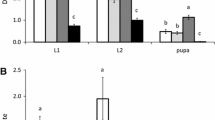Abstract
Larval and adult predators comprise the largest component of the natural enemy fauna which attack the semi-aquatic rice caseworm Nymphula depunctalis (Guenée). Spiders, birds, and adult dragonflies/damselflies were the dominant predators of caseworm adults, while aquatic beetle larvae, aquatic bug nymphs and adults, and ants preyed on caseworm larvae. Egg parasitolds are unknown in nature and larval/pupal parasitoids are rare. A nuclear polyhedrosis virus, the only recorded pathogen, occurs but rarely. A ricefield pulmonate snail Lymnaea quadrasi (Mollendorff), which forages on algae, causes limited caseworm egg mortality in a passive and fortuitous manner. Water beetles—the dytiscid Cybister tripunctatus orientalis Gschwendtner and hydrophilid Sternolophus rufipes Fabricius—are voracious larval predators. Prey consumption by these water beetles is higher on older caseworm larvae whose larger size creates more movement while the larvae are crossing the water surface. Also, older caseworms are more prone to leave the protection of their cases while under attack. Younger caseworm larvae, however, tend to retract and remain motionless when attacked. The last instar dytiscid preyed on an average of 11.4 caseworm larvae per day while that of the hydrophilid preyed on 6.7 larvae per day.
Résumé
Les predateurs de larves et d’adultes constituent la composante principale des ennemies naturels de Nymphula (Nymphula depunctalis Guenée). Les araignées, les oiseaux et les libellules sont les principaux prédateurs d’adultes, tandis que les Coléopters aquatiques, les punaises d’eau, et les fourmis attaquent les larves. II n’y a pas de parasites d’oeufs connus dans la nature, et les parasites de larves/pupes sont rares. Une polyèdrose nucléaire virulante existe, mais est rarement trouvée. Un escargot pulmoné de rizière (Lymnaea quadrasi Mollendorf), qui se nourrit d’algues constitue indirectement une cause mineure et fortuite de mortalité pour les oeufs. Les Coléopters aquatiques(le dysticide Cybistes tripunctatus orientalis Gschwendtner et l’hydrophilide Sternolophus rufipes Fabricius) sont des prédateurs de larves particulièrement actifs. La predation par ces Coléopters aquatiques est plus importante sur les larves âgées, qui par leur taille provoquent des turbulences plus importantes lors de leurs mouvements sur la surface le l’eau, et qui ont tendance a quitter facilement leurs abris. Les larve plus jeunes ont tendance à s’y retirer et à rester immobiles lorsqu’elles sont attaquées. C. tripunctatus orientalis au dernier stade larvaire a une activité prédatrice plus élevée que celle des S. rufipes.
Similar content being viewed by others
References
Bandong J. P. and Litsinger J. A. (1981) Method for mass-rearing the rice caseworm Nymphula depunctalis. Int. Rice Res. Newsl. 6(1), 3–4.
Chowdhury M. A. (1977) Some studies on natural enemies of rice insects. M. Sc. thesis, Entomology Department, Faculty of Agriculture, Bangladesh University, Dacca. 86 p.
De Lara A. V. and Enriquez G. L. (1981) Life history of laboratory-reared Radix quadrasi (Gastropoda: Pulmonata). Philipp. J. Biol. 10, 242–254.
International Rice Research Institute (IRRI) (1982) pages 180–181. In IRRI Annual Report for 1981. Control and management of rice pests. Insects. Aquatic invertebrate fauna in rice fields. IRRI, Los Baños, Philippines.
Jacob A., Pillai K. S. and Asari P. A. R. (1978) A nuclear polyhedrosis virus from rice case worm, Nymphula depunctalis (Guen.) (Lepidoptera:Pyralidae). Curr. Sci. 47, 928–929.
Mienis H. K. (1989) The marsh slug Deroceras laeve (Mollusca, Gastropoda) feeding on the Florida wax scale Ceroplastes floridens (Insecta, Phynchota) in Israel. Z. Angew. Zool. 76, 377–378.
Mogi M., Miyagi I. and Cabrera B. D. (1984) Development and survival of immature mosquitoes (Diptera: Culicidae) in Philippine rice fields. J. Med. Entomol. 21, 283–291.
Nigam H. C. (1979) Food and feeding habits of Rana tigrina (Daud) in paddy belts of Uttar Pradesh. Geobios 6, 241–244.
Perez M. L. and Cadapan E. P. (1986) The efficacy of Trichogramma species as biological control agents against some rice insect pests. Philipp. Entomol. 6, 463–470.
Sasmal S., Kulshreshtha J. P. and Mathur K. C. (1984) Lymnaeae auricularia (L.) race Swinhoe (H. Adams), a predatory snail of rice brown planthopper, Nilaparvata lugens (Stal). Oryza 22, 57.
Sison P. (1938) Some observations on the life history, habits and control of the rice casewom, Nymphula depunctalis Guen. Philipp. J. Agric. 9, 273–301.
Steel R. G. and Torrie J. H. (1980) Principles and Procedures of Statistics. 2nd ed. McGraw Hill, New York, 633 pp.
Supmo F. (1916) Triaenodesbicolor and Hydrocampa nympaeata in the rice fields of the Province of Milan, Italy. cited in Rev. Appl. Entomol., 5, 43–44. 1917.
You, Lanshao, Xiong Shulin, and Wang Zongdian. (1988) Annotated list of Apanteles foerster (Hymenoptera: Braconidae) from China. Entomol. Scand. 19, 35–42.
Author information
Authors and Affiliations
Rights and permissions
About this article
Cite this article
Litsenger, J.A., Chantaraprapha, N., Barrion, A.T. et al. Natural Enemies of the Rice Caseworm Nymphula Depunctalis (Guenée) (Lepidoptera: Pyralidae). Int J Trop Insect Sci 15, 261–268 (1994). https://doi.org/10.1017/S1742758400017550
Received:
Accepted:
Published:
Issue Date:
DOI: https://doi.org/10.1017/S1742758400017550




